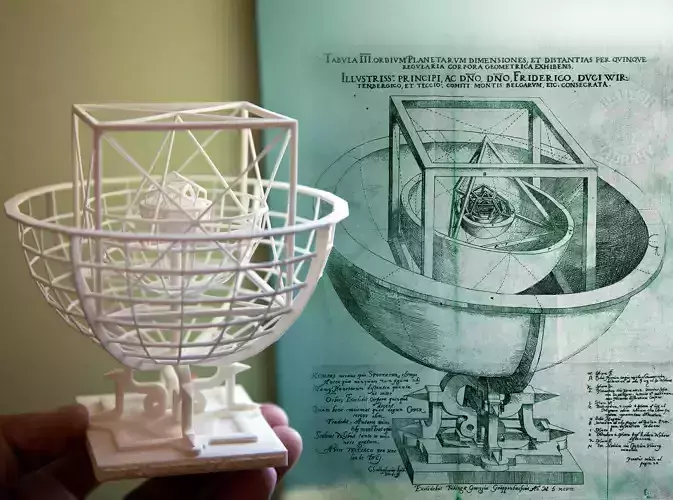1/8
An early cosmological model of our solar system, in full 3d-printed detail. From Kepler's book _Mysterium Cosmographicum_, 1596. Kepler thought that the planets orbited the Earth, each within an orbit set on a regular polyhedron. He was mightily wrong, but his design is iconic and inspiring.
All regular polyhedra are represented, in this order from the inside out: octahedron, icosahedron, dodecahedron, tetrahedron, cube. I also included the text from the page of Kepler's book, Tabvla III Orbivm Planetarvm and Johannes Kepler on the opposite side of the base.
Try coloring it! The material is porous and you can submerge it into tea, wine, etc to give it color.
Notes on Kepler's work and this planetary model:
_In the XVI century, the German astronomer Johannes Kepler (1571-1630) tried to find a relation among the five regular platonic solids and the six planets known in his time: Mercury, Venus, Earth, Mars, Jupiter and Saturn. Kepler thought the two numbers were connected: the reason there were only six planets was because there were only five regular solids.
In 1596, in his work Mysterium Cosmographicum, Kepler established a model of the solar system where the five platonic solids were inserted one inside another, separated by a series of inscribed spheres. He realized that the ratios among the planets orbits' radii could match the ratios among the spheres' radii. His model, however, was not supported by the experimental data from the astronomers Tycho Brahe (Danish, 1546-1601) and Nicolau Copernicus (Polish, 1473-1543). Indeed, his model was entirely disapproved by posterior discoveries of the planets Uranus and Neptune: there are no additional platonic solids that determine their distances to the Sun. However, from his research, new solids were discovered (that, nowadays, are named after him), the perception that the orbits of the planets are not circles but ellipses, and the three laws of the planetary motion._
REVIEWS & COMMENTS
accuracy, and usability.








